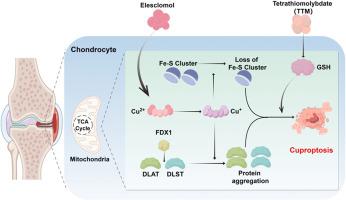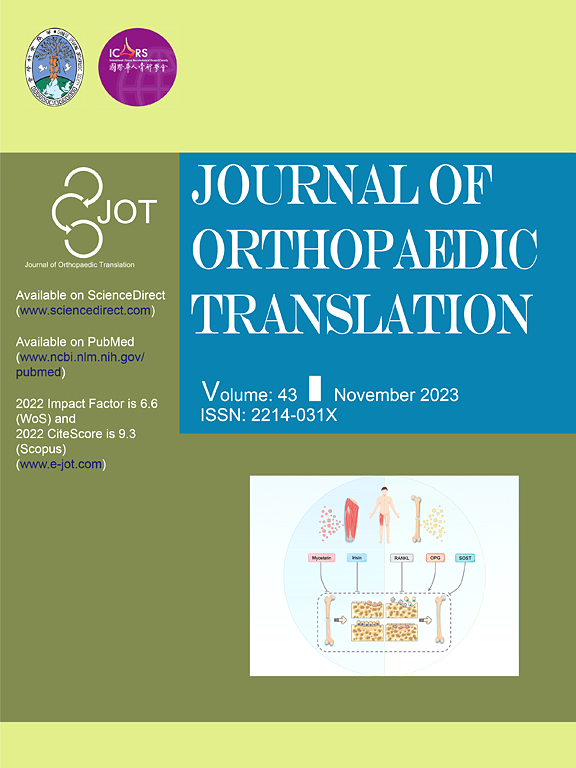骨关节炎中的铜倾:探讨软骨细胞铜倾和治疗途径
IF 5.9
1区 医学
Q1 ORTHOPEDICS
引用次数: 0
摘要
背景cuprotosis是一种新发现的细胞死亡形式,与骨关节炎(OA)发病机制的潜在相关性尚不清楚。本研究旨在探讨软骨细胞铜增生与OA之间的关系,并评价铜离子螯合剂四硫钼酸盐(TTM)在OA治疗中的治疗潜力。方法收集临床软骨标本和动物标本,采用显微ct、组织病理染色、免疫组织化学、电感耦合等离子体质谱(ICP-MS)等方法评估骨性关节炎进展过程中软骨细胞铜增生的可能性。在体外,我们使用埃斯氯莫尔和硫酸铜在小鼠软骨细胞中建立了铜增生模型。采用ICP-MS、CCK-8等技术探讨骨关节炎发展中铜突的作用。为了评估TTM是否可以减轻软骨细胞铜增生和减缓OA进展,在细胞和动物水平上应用了各种方法。代谢组学预测了TTM潜在的OA改善途径。采用分子对接方法预测TTM的干预靶点。通过敲除硅谷胱甘肽合成酶(si-GSS)质粒和外源性谷胱甘肽补充剂,研究了谷胱甘肽(GSH)对软骨细胞铜增生和OA发展的影响。结果OA过程中,软骨细胞铜离子含量升高,软骨基质代谢紊乱,铜还原相关蛋白脂酰胺脱氢酶(DLAT)、二氢脂酰胺琥珀基转移酶(DLST)、铁氧还蛋白1 (FDX1)低表达,热休克蛋白70 (HSP70)高表达。线粒体作为铜裂的主要靶点,在这一过程中对呼吸功能和形态产生重大影响。TTM通过促进GSH表达增强软骨细胞对铜增生的抵抗力,从而改善OA表型。结论软骨细胞铜增生是骨性关节炎发病和进展的重要组成部分,而TTM已成为治疗骨性关节炎的一种新颖且具有潜在价值的治疗策略。软骨细胞铜增生在膝骨关节炎的发生和发展中起着关键作用。铜离子螯合剂(四硫钼酸盐)已被证明能够通过减轻软骨细胞铜增生来治疗膝关节骨关节炎。本文章由计算机程序翻译,如有差异,请以英文原文为准。

Cuproptosis in osteoarthritis: Exploring chondrocyte cuproptosis and therapeutic avenues
Background
Cuproptosis, a newly identified form of cell death, presents an as-yet-unclear potential correlation with Osteoarthritis (OA) pathogenesis. This study aimed to explore the relationship between chondrocyte cuproptosis and OA, and to evaluate the therapeutic potential of the copper ion chelator tetrathiomolybdate (TTM) in OA treatment.
Methods
We collected clinical cartilage samples and animal specimens, employing Micro-CT, histopathological staining, immunohistochemistry, and Inductively Coupled Plasma Mass Spectrometry (ICP-MS) to evaluate the potential occurrence of chondrocyte cuproptosis during OA progression. In vitro, we used elesclomol and copper sulfate to create a cuproptosis model in mouse chondrocytes. Techniques like ICP-MS, CCK-8, and others were used to explore the role of cuproptosis in OA development. To assess if TTM can mitigate chondrocyte cuproptosis and decelerate OA progression, various methods were applied at cellular and animal levels. Metabolomics predicted pathways for TTM's potential OA improvement. Molecular docking was employed to predict the intervention target of TTM. The impact of glutathione (GSH) on chondrocyte cuproptosis and OA development was studied using si-glutathione synthetase (si-GSS) plasmid knockdown and exogenous GSH supplements.
Results
Our findings indicate that in the process of OA, chondrocytes show an increase in copper ion content, metabolic disorders of the cartilage matrix, low expression of cuproptosis - related proteins lipoamide dehydrogenase (DLAT), dihydrolipoamide succinyltransferase (DLST), and ferredoxin 1 (FDX1), and high expression of the heat shock protein70 (HSP70). As the primary target of cuproptosis, mitochondria experience significant impacts on respiratory function and morphology during this process. TTM enhances chondrocytes resistance to cuproptosis by promoting GSH expression, thus ameliorating the OA phenotype.
Conclusion
Chondrocyte cuproptosis is integral to pathogenesis and progression of OA, and TTM has emerged as a novel and potentially valuable therapeutic strategy for the treatment of this disease.
The translational potential of this article
Chondrocyte cuproptosis plays a key role in the occurrence and development of knee osteoarthritis. The copper ion chelator (Tetrathiomolybdate) has been proved to be able to treat knee osteoarthritis by alleviating chondrocyte cuproptosis.
求助全文
通过发布文献求助,成功后即可免费获取论文全文。
去求助
来源期刊

Journal of Orthopaedic Translation
Medicine-Orthopedics and Sports Medicine
CiteScore
11.80
自引率
13.60%
发文量
91
审稿时长
29 days
期刊介绍:
The Journal of Orthopaedic Translation (JOT) is the official peer-reviewed, open access journal of the Chinese Speaking Orthopaedic Society (CSOS) and the International Chinese Musculoskeletal Research Society (ICMRS). It is published quarterly, in January, April, July and October, by Elsevier.
 求助内容:
求助内容: 应助结果提醒方式:
应助结果提醒方式:


